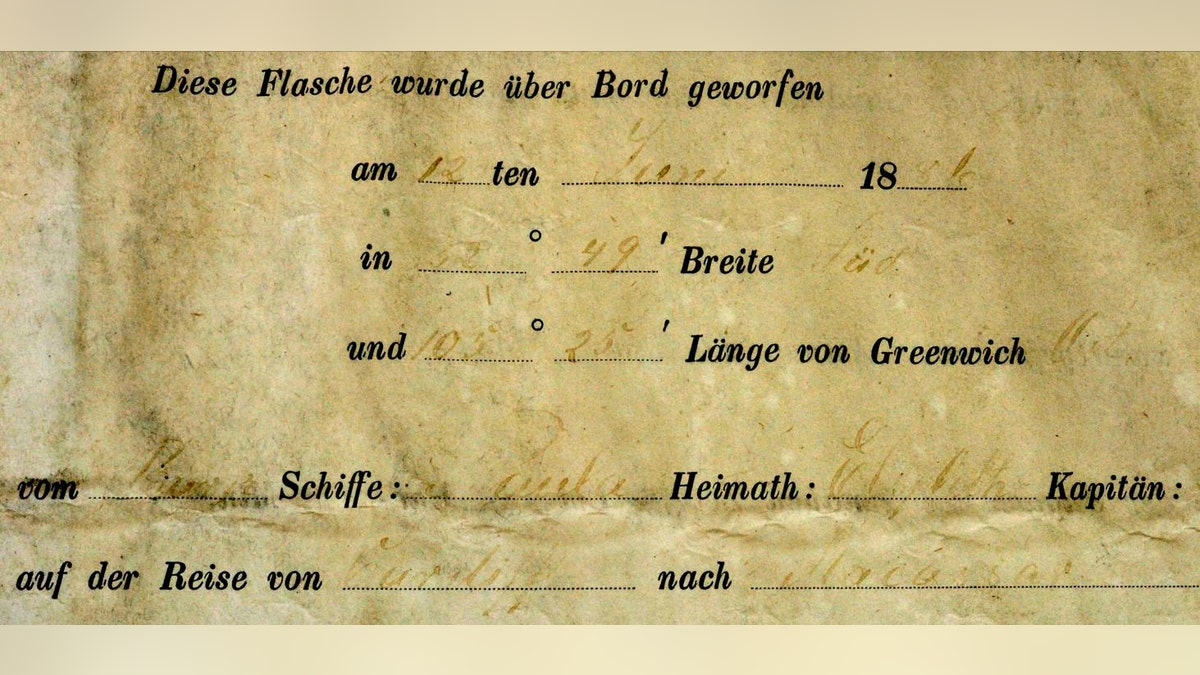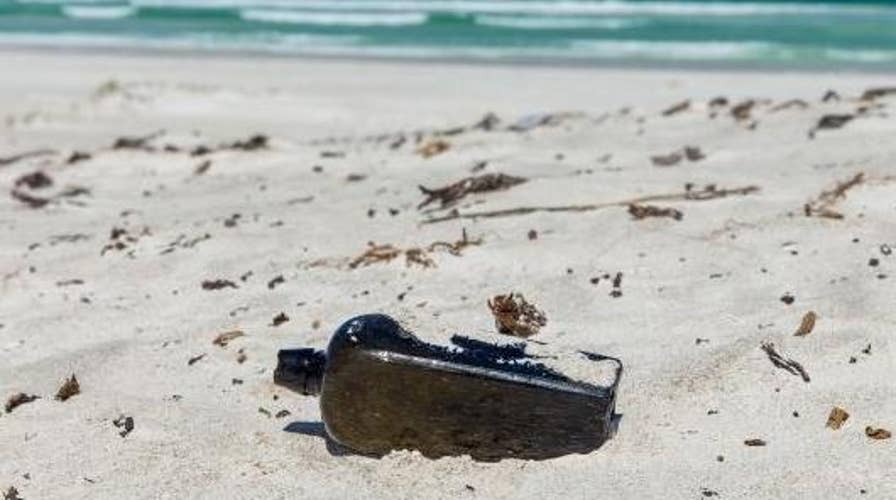World’s oldest message-in-a-bottle found
A message-in-a-bottle dated back to 1886 was found on an Australian beach by a family.
The world’s oldest message in a bottle has been discovered on a beach in Western Australia, almost 132 years after it was thrown into the ocean.
The mysterious bottle in Australia was half-buried in sand when it was discovered by Tonya Illman just north Wedge Island, 112 miles north of Perth. With her son’s car bogged in the beach's soft sand, Illman spotted the object nearby.
The previous record for oldest message in a bottle was an artifact that washed up in Germany in 2015, some 108 years, four months and 18 days after it was thrown into the North Sea as part of a British research project.
EXTREMELY RARE COPY OF THE DECLARATION OF INDEPENDENCE, ONCE HIDDEN BEHIND WALLPAPER, SURFACES
“My friend Grace Ricciardo and I were walking across the dunes when I saw something sticking out of the sand so I went to take a closer look,” said Mrs. Illman, in a statement released by the Western Australian Museum. “It just looked like a lovely old bottle so I picked it up thinking it might look good in my bookcase. My son’s girlfriend was the one who discovered the note when she went to tip the sand out.”

Tony Illman discovered the message in a bottle. (Image copyright KymIllman.com)
Mrs. Illman took the note home and, after drying it out, noticed that the message was a printed form, in German, with German handwriting on it. Her husband Kym researched the find and discovered that the form, dated June 12, 1886, was part of a massive German oceanographic experiment.
The bottle had been jettisoned from “Paula,” a German sailing ship, as part of a “drift bottle experiment” to study ocean currents and find more efficient trade routes.
LONG-LOST BABE RUTH WWII-ERA RADIO INTERVIEW FOUND IN OBSCURE ARCHIVE
Thousands of bottles were thrown overboard from German ships as a part of the research, which ran from 1864 until 1933. The ship’s captain wrote the date and the vessel’s coordinates, its home port and route on the printed form. On the back of the form, finders were asked to write when and where the bottle was found. Finders were also asked to return the form to either the German Naval Observatory in Hamburg or the nearest German consulate.

An enhanced image shows handwritten details of the date and coordinates when message when it was thrown into the sea. It also has details of the "Paula's" name, home port and voyage (Ross Anderson/WA Museum)
“After much digging, we were able to make out the date, the coordinates, the ship’s name and direction of the voyage (Cardiff in Wales to Makassar in the Dutch East Indies, now Indonesia),” said Mr. Illman. “It was clearly very exciting but we needed a lot more information. We wanted to know if what we had found was historically significant or a very inventive hoax.”
The Perth couple took their find to the Western Australian Museum, where experts confirmed that the bottle was a mid to late-19th-century Dutch gin bottle. The form was also found to be consistent with cheaply-made 19th-century paper, according to the museum.
PICASSO MASTERPIECE REVEALS LOST PAINTING, HIDDEN DETAILS
Research also confirmed that “Paula” sailed from Wales to Makassar in 1886.

The oldest message in a bottle discovered was discovered on a beach in Western Australia. (Image copyright KymIllman.com)
“Incredibly, an archival search in Germany found Paula’s original Meteorological Journal and there was an entry for 12 June 1886 made by the captain, recording a drift bottle having been thrown overboard,” explained Dr. Ross Anderson, assistant curator maritime archaeology at the Western Australian Museum, in the statement. “The date and the coordinates correspond exactly with those on the bottle message.”
The bottle was thrown into the Indian Ocean, 590 miles from where it washed up.
'INCREDIBLE' 900-YEAR-OLD COPPER ARROWHEAD DISCOVERED ON CANADIAN MOUNTAIN
The find’s authenticity was confirmed by the German Federal Maritime and Hydrographic Agency (BSH) and National Meteorological Service of the Federal Republic of Germany (DWD), which are offshoots of the German Naval Observatory, and the Western Australian Museum.
Of the thousands of bottles thrown into the ocean, only 662 messages were returned to Hamburg, and none of the bottles. The bottle found on the Australian beach brings the total of returned messages to 663. The last bottle and note washed up in Denmark – they were found on Jan. 7 1934.
The Illmans have loaned their find to the Western Australian Museum to display for the next two years.
Follow James Rogers on Twitter @jamesjrogers

